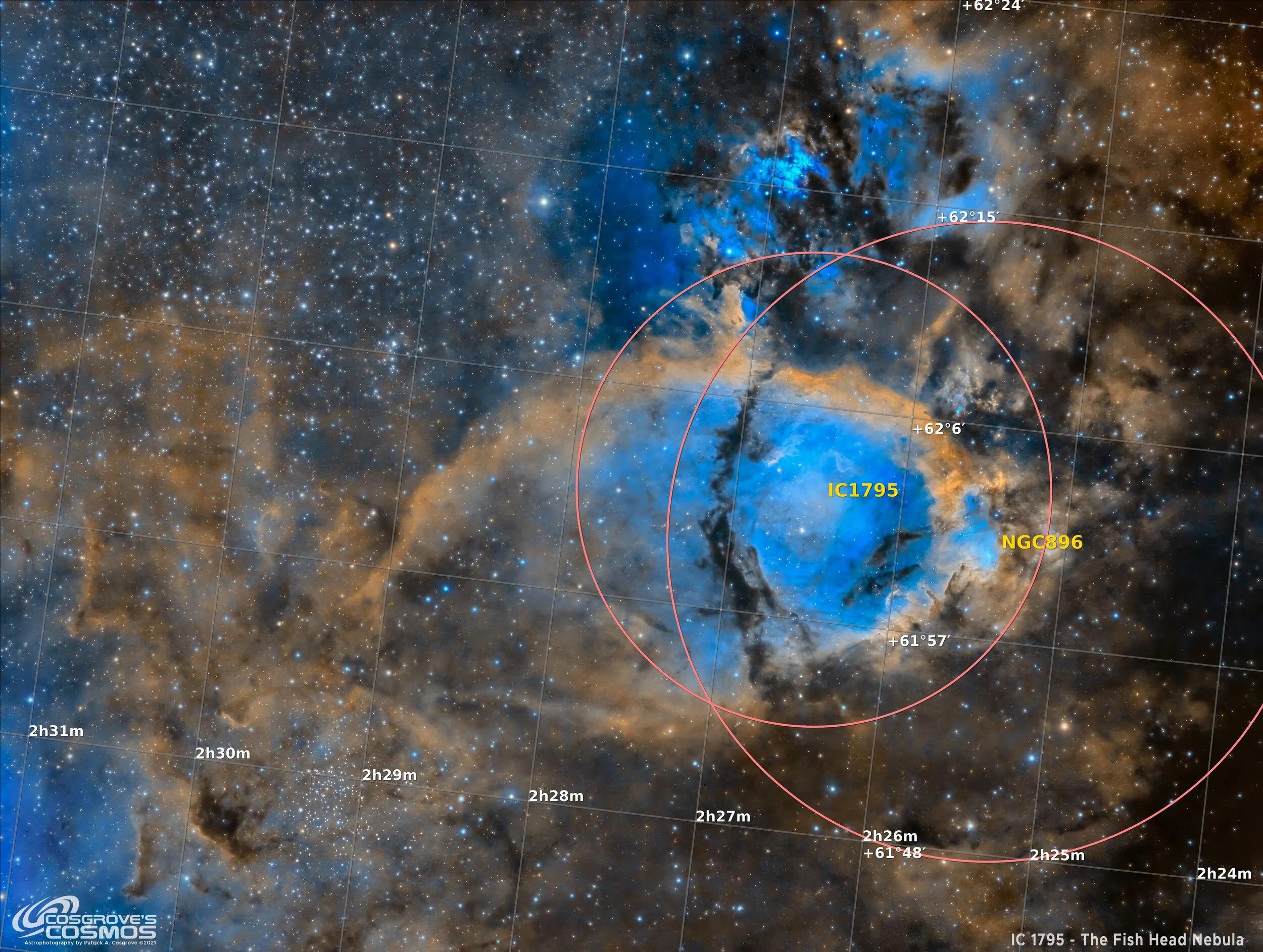IC 1795 - The Fish Head Nebula in SHO
Date: November 14th, 2020
Cosgrove’s Cosmos Catalog ➤#0060
Table of Contents Show (Click on lines to navigate)
About the Target
IC 1795, also know as the Fish Head Nebula, is an area of new star formation with glowing gas and dust, in the constellation of Cassiopeia. It is actually a portion of the larger Heart Nebula complex (IC 1805) that is located about 6000 light-years from earth. Since my scope cannot fit the entire Heart nebula into its field of view, I opted to frame just the fish head portion of the nebula. This was to be shot with my Mono camera and narrowband filters so that I could get the Hubble Palette colors that I am quite fond of.
The Annotated Image
The annotated image was created using the ImageSolver and AnnotateImage scripts in Pixinsight.
About the Project
This was shot was taken over two nights (November 12th & 14th) and is the result of 5 hours of total integration. I would have liked to get another couple of nights’ data on this target, but I feel pretty fortunate to have gotten two nights of data during the month of November in Upstate NY! The second evening was cut short as a bank of clouds moved in around midnight.
At this point, I have only processed a few images in the Hubble Palette so I am still feeling my way through this. In general, a mono camera generates a lot more images, and each filter layer being dealt with must be processed on its own until you are ready to combine the images into a color image. You have to have a system for doing this or it is easy to get confused. In fact, I got confused within this image. I had created a synthetic luminance image by using the ImageIntegration process in pixinsight to combine the master Ha, OIII, and SII images. ImageIntgration will combine them weighting the image that has less noise higher. Then you process the color image for color and you process the luminance image for contrast and sharpness. Towards the tail end of the process, you fold the Lum image into the color image and you get the best of both worlds.
Well, I had finished the processing, as I typically do, I shared a copy via email with a small group of practicing astrophotographers in the Rochester Area. They quickly came back to me saying “ ahh - nice colors - but the sharpness is really bad - your images are usually much sharper than this - what happened?” I looked at the image again and suddenly it was obvious that I had lost sharpness somehow. I was so bleary-eyes doing the processing that I did not notice it. I looked at what I had done and I realized that instead of grabbing the sharp synthetic luminance file and folding it in, I had grabbed a luminance mask that I had created for another process. In this one, I had run convolution on it to soften the edges of the mask. Needless to say - that was a very poor image to use as the Lum master image you were folding the color image. I quickly corrected that mistake and created the image you see above!
There is a real tendency to want to boost the colors to make things stand out more - and I have to say that I am a sucker for higher saturations. But it is really easy t take things too far so I am learning to control myself and not go crazy with the color sat. I feel the image above has a lot of colors but does not go too far.
The Location in the Sky
FreeStarChart,com Constellation map showing the location of the FIsh Head Nebula indicated by a yellow arrow.
Capture Details
Light Frames
24 x 300 seconds, bin 1x1 @ -15C, unity gain, ZWO Gen II Ha Filter
22 x 300 seconds, bin 1x1 @ -15C, unity gain, ZWO Gen II O3 Filter
16 x 300 seconds, bin 1x1 @ -15C, unity gain, ZWO Gen II S2 Filter
Total of 5.1 hours
Cal Frames
50 Bias exposures
25 Dark exposures
45 Ha Flats
45 O3 Flats
45 S2 Flats
Capture Hardware
Scope: Astrophysics 130mm Starfire F/8.35 APO refractor
Guide Scope: Televue 76mm Doublet
Camera: ZWO ASI1600mm-pro with ZWO Filter wheel with ZWO filter set
Guide Camera: ZWO ASI290Mini
Focus Motor: Pegasus Astro Focus Cube 2
Camera Rotator: Pegasus Astro Falcon
Mount: Ioptron CEM60
Polar Alignment: Polemaster camera
Software
Capture Software: PHD2 Guider, Sequence Generator Pro controller
Image Processing: Pixinsight, Photoshop - assisted by Coffee, extensive processing indecision and second-guessing, editor regret and much swearing…..



Standardizing the base
Finally, the Tri-Pier and the its extension column arrived. This allowed me to standardize the base of the two telescope platforms. There are several reasons that made this useful. First - everything is the same when you are handling things in the dark. And secondly, I was in the process of revolutionizing how I setup at night…..